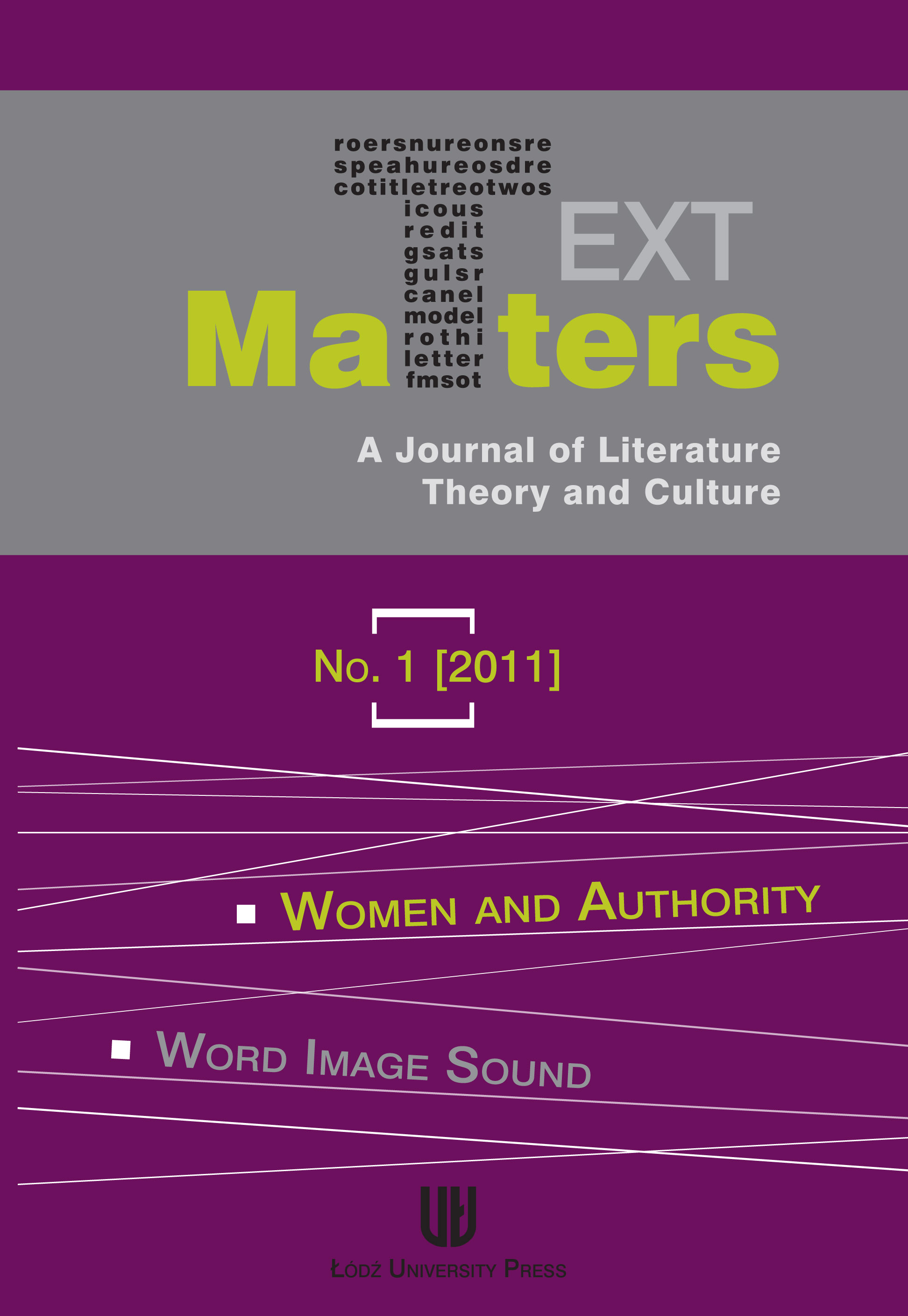One, Mad Hornpipe: Dance as a Tool of Subversion in Brian Friel’s Molly Sweeney
DOI:
https://doi.org/10.2478/v10231-011-0019-2Abstract
The plot of Brian Friel's Molly Sweeney oscillates around the theme of perception, blindness and eye-sight recovery. Although visually impaired, the eponymous character is a self-reliant and independent person who is very active, both professionally and socially. What serves as the source of tragedy in the play is the male desire to compensate for Molly's physical disability perceived as a sign of deficiency and oddity that needs to be normalized. Prompted by her husband, Molly decides to undergo a surgery which gives her a chance to regain sight and, thus, become a part of the world of the visually abled. Yet, subsequent to the operation, Molly cannot adapt herself to the new reality and develops a medical condition called blindsight, which leads to her final alienation and confusion.
Focusing predominantly on the main character of the play, this paper examines the ways in which Molly Sweeney experiences the surrounding world and seeks satisfaction and self-fulfilment through physical activities, such as swimming or dancing, which she vividly describes in her monologues. It explores the double nature of Molly who, despite her self-sufficiency, capacity for rebellion and a sense of autonomy, seems prone to male manipulation exercised at first by her father, later by her husband Frank and doctor Rice. Her expression of independence becomes particularly conspicuous in the scene of a party organized the night before her surgery when she performs a wild and frantic hornpipe, which serves as a form of momentary upheaval and a visualization of the outburst of extreme emotions. Although the dance is not presented onstage, it has a crucial function in the play, for it serves as its powerful climax, after which Molly experiences gradual deterioration.
Interpreted in the context of the history of Irish dance, the mad hornpipe appears replete with meanings and allusions. Traditionally associated with human sexuality and the female element, dance was often treated by the Irish clergy with a great deal of distrust as a source of evil and moral corruption. Consequently, like in the case of the frenzied reel in another famous Frielian play, Dancing at Lughnasa, the limitless and unrestricted performance in the climactic scene of Molly Sweeney may be seen as a tool of subversion and female opposition to the Irish patriarchal order. It is a unique moment in which the protagonist seizes male power and gains full, though very temporary, control over her life.
Downloads
References
Bertha, Csilla. "Brian Friel as Postcolonial Playwright." The Cambridge Companion to Brian Friel. Ed. Anthony Roche. Cambridge: Cambridge University Press 2006. 154-65.
Google Scholar
Breathnach, Breandán. Folk Music and Dances of Ireland. Dublin and Cork: Mercier 1980.
Google Scholar
Brennan, Helen. The Story of Irish Dance. Lanham: Roberts Rinehart 2001.
Google Scholar
Cave, Richard Allen. "Questing for Ritual and Ceremony in a God-forsaken World: Dancing at Lughnasa and Wonderful Tennessee." Brian Friel's Dramatic Artistry: ‘The Work Has Value.’ Ed. Donald E. Morse Csilla Bertha and Mária Kurdi. Dublin: Carysfort 2006. 181-204.
Google Scholar
Cohen, Marshall. "Primitivism Modernism and Dance Theory." What is Dance? Readings in Theory and Criticism. Ed. Marshall Cohen and Roger Copeland. Oxford: Oxford University Press 1983. 161-77.
Google Scholar
Coult, Tony. About Friel: the Playwright and the Work. London: Faber 2003.
Google Scholar
Fraleigh, Sondra Horton. Dance and the Lived Body: A Descriptive Aesthetics. Pittsburg: University of Pittsburg Press 1987.
Google Scholar
Friel, Brian. Dancing at Lughnasa. London: Faber 1990.
Google Scholar
Friel, Brian. Molly Sweeney. New York: Dramatist Play Service 1996.
Google Scholar
Friel, Brian. Wonderful Tennessee. Loughcrew: Gallery 1993.
Google Scholar
Gardner, Howard. Frames of Mind: The Theory of Multiple Intelligences. New York: Basic 1983.
Google Scholar
Kavanagh, Donncha, Kieran Keohane and Carmen Kuhling. "Dance-work: Images of Organisation in Irish Dance." SAGE Directions in Organization Studies. Ed. S. R. Clegg. London: SAGE 2008. 725-42.
Google Scholar
Levin, David Michael. "Philosophers and the Dance." What is Dance? Readings in Theory and Criticism. Ed. Marshall Cohen and Roger Copeland. Oxford: Oxford University Press 1983. 85-93.
Google Scholar
McMullan, Anna. "Performativity Unruly Bodies and Gender in Brian Friel's Drama." The Cambridge Companion to Brian Friel. Ed. Anthony Roche. Cambridge: Cambridge University Press 2006. 142-53.
Google Scholar
Moloney, Karen M. "Molly Astray: Revisioning Ireland in Brian Friel's Molly Sweeney." Twentieth Century Literature 16 (2000): 285-310.
Google Scholar
Mulrooney, Deidre ed. Irish Moves: An Illustrated History of Dance and Physical Theatre in Ireland. Dublin: Liffey 2006.
Google Scholar
Murray, Christopher. "Friel and O'Casey Juxtaposed." Irish University Review 29 (1999): 16-29.
Google Scholar
Murray, Christopher. "Molly Sweeney and its Sources: A Postmodern Case Study." Brian Friel's Dramatic Artistry: ‘The Work Has Value.’ Ed. Donald E. Morse Csilla Bertha and Mária Kurdi. Dublin: Carysfort 2006. 229-50.
Google Scholar
Niel, Ruth. "Disability as Motif and Meaning in Brian Friel's Drama." Brian Friel's Dramatic Artistry: ‘The Work Has Value.’ Ed. Donald E. Morse Csilla Bertha and Mária Kurdi. Dublin: Carysfort 2006. 205-28.
Google Scholar
O'Brien, George. "The Late Plays." The Cambridge Companion to Brian Friel. Ed. Anthony Roche. Cambridge: Cambridge University Press 2006. 91-103.
Google Scholar
Pine, Richard. The Diviner: The Art of Brian Friel. Dublin: University College Dublin Press 1999.
Google Scholar
Royce, Anya Peterson. The Anthropology of Dance. Alton: Dance 2002.
Google Scholar
Sweeney, Bernadette. Performing the Body in Irish Theatre. New York: Palgrave Macmillan 2008.
Google Scholar
Wyschogrod, Edith. "Blind Man Seeing: From Chiasm to Hyperreality." Crossover Queries: Dwelling with Negatives Embodying Philosophy's Others. New York: Fordham University Press 2006. 112-24.
Google Scholar
Downloads
Published
How to Cite
Issue
Section
License

This work is licensed under a Creative Commons Attribution-NonCommercial-NoDerivatives 4.0 International License.













